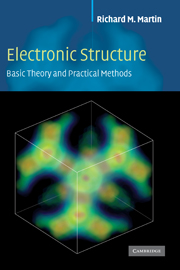Book contents
- Frontmatter
- Contents
- Preface
- Acknowledgments
- Notation
- Part I Overview and background topics
- Part II Density functional theory
- Part III Important preliminaries on atoms
- Part IV Determination of electronic structure: the three basic methods
- 12 Plane waves and grids: basics
- 13 Plane waves and grids: full calculations
- 14 Localized orbitals: tight-binding
- 15 Localized orbitals: full calculations
- 16 Augmented functions: APW, KKR, MTO
- 17 Augmented functions: linear methods
- Part V Predicting properties of matter from electronic structure – recent developments
- Appendix A Functional equations
- Appendix B LSDA and GGA functionals
- Appendix C Adiabatic approximation
- Appendix D Response functions and Green's functions
- Appendix E Dielectric functions and optical properties
- Appendix F Coulomb interactions in extended systems
- Appendix G Stress from electronic structure
- Appendix H Energy and stress densities
- Appendix I Alternative force expressions
- Appendix J Scattering and phase shifts
- Appendix K Useful relations and formulas
- Appendix L Numerical methods
- Appendix M Iterative methods in electronic structure
- Appendix N Code for empirical pseudopotential and tight-binding
- Appendix O Units and conversion factors
- References
- Index
15 - Localized orbitals: full calculations
from Part IV - Determination of electronic structure: the three basic methods
Published online by Cambridge University Press: 05 June 2012
- Frontmatter
- Contents
- Preface
- Acknowledgments
- Notation
- Part I Overview and background topics
- Part II Density functional theory
- Part III Important preliminaries on atoms
- Part IV Determination of electronic structure: the three basic methods
- 12 Plane waves and grids: basics
- 13 Plane waves and grids: full calculations
- 14 Localized orbitals: tight-binding
- 15 Localized orbitals: full calculations
- 16 Augmented functions: APW, KKR, MTO
- 17 Augmented functions: linear methods
- Part V Predicting properties of matter from electronic structure – recent developments
- Appendix A Functional equations
- Appendix B LSDA and GGA functionals
- Appendix C Adiabatic approximation
- Appendix D Response functions and Green's functions
- Appendix E Dielectric functions and optical properties
- Appendix F Coulomb interactions in extended systems
- Appendix G Stress from electronic structure
- Appendix H Energy and stress densities
- Appendix I Alternative force expressions
- Appendix J Scattering and phase shifts
- Appendix K Useful relations and formulas
- Appendix L Numerical methods
- Appendix M Iterative methods in electronic structure
- Appendix N Code for empirical pseudopotential and tight-binding
- Appendix O Units and conversion factors
- References
- Index
Summary
Summary
As emphasized in the previous chapter, localized functions provide an intuitive description of electronic structure and bonding. This chapter is devoted to quantitative methods in which the wavefunction is expanded as a linear combination of localized atomic(-like) orbitals, such as gaussians, Slater-type orbitals, and numerical radial atomic-like orbitals. Such calculations can be very efficient; they can also be very accurate, as shown by the highly developed codes used in chemistry; and they provide the basis for creation of new methods, such as “order-N” (Ch. 23) and Green's function approaches. There is a cost, however: full self-consistent DFT calculations require specification of the basis, and the price paid for efficiency is loss of generality (in contrast to the “one basis fits all” philosophy of plane wave methods). Since details depend upon the basis, we can only describe general principles with limited examples.
It is instructive to note that there are important connections to localized muffin-tin orbitals (MTOs) (Ch. 16), the linear LMTO method (Ch. 17). This has led to an “ab initio tight-binding” method (Sec. 17.6) in which a minimal basis of orthogonal localized orbitals is derived from the Kohn–Sham hamiltonian.
Solution of Kohn–Sham equations in localized bases
The subject of this chapter is the class of general methods for electronic structure calculations in terms of the localized atom-centered orbitals defined in Sec. 14.1. The orbitals may literally be atomic orbitals, leading to the LCAO method or various atomic-like orbitals.
- Type
- Chapter
- Information
- Electronic StructureBasic Theory and Practical Methods, pp. 298 - 312Publisher: Cambridge University PressPrint publication year: 2004



